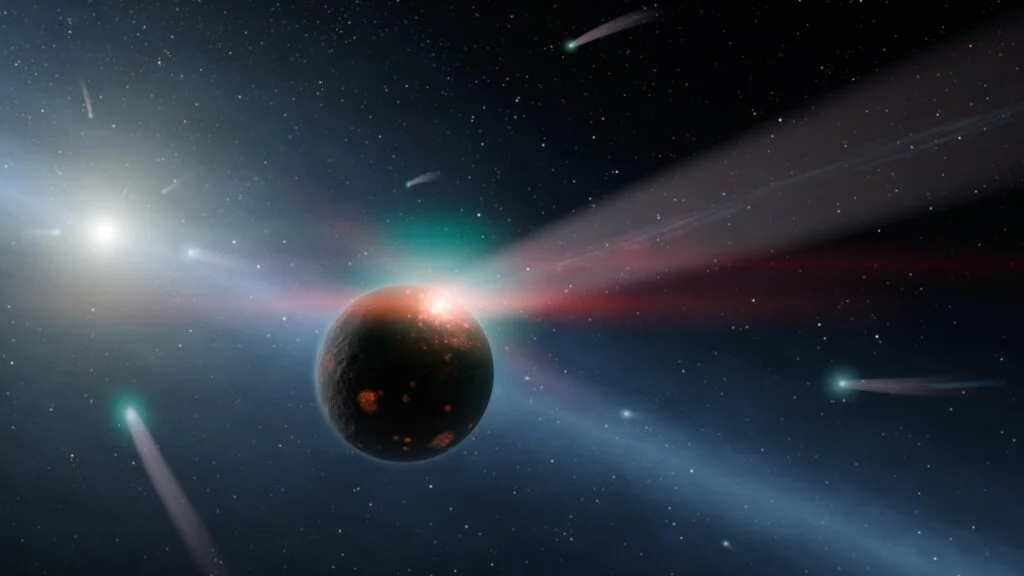A Sun-sized star passed through our system 2.5 million years ago
- December 21, 2023
- 0
Recently the star HD 7977 flew close to the Sun by astronomical standards. It’s probably close enough to touch the Oort cloud. Scientists analyzed how it and other
Recently the star HD 7977 flew close to the Sun by astronomical standards. It’s probably close enough to touch the Oort cloud. Scientists analyzed how it and other

Recently the star HD 7977 flew close to the Sun by astronomical standards. It’s probably close enough to touch the Oort cloud. Scientists analyzed how it and other guest stars might affect objects in the Solar System. Astronomers have been analyzing data from the Gaia probe for several years, looking for objects that have approached the solar system in the past or will approach it in the future. One of these objects, located about 246.9 light-years from us today, became known as HD 7977, a yellow dwarf with the same mass as the Sun.
Analysis of the latest data from the Gaia probe revealed that HD 7977 flew by at a distance of several thousand astronomical units (an astronomical unit is the average distance from the Sun to the Earth) about 2.47 million years ago.
The Oort cloud, a spherical layer of icy objects surrounding the Sun, is located between two and 10 thousand astronomical units away. Therefore, the star had to disturb objects in the cloud and long-period comets. To understand how large the impact could be, an international group of scientists simulated the interaction between the star HD 7977 and objects in the Solar System.
To start, scientists combined known data on HD 7977. It turns out that it may be a double star, as indicated by several independent parameters of its motion and spectral properties.
According to researchers’ calculations, about 2.47 million years ago this star approached the Sun at a distance of less than 12.3 thousand astronomical units (with a 90% probability, that is, less than 0.2 light years), or even less than 2.5 thousand. astronomical units (10% probability – less than 0.05 light years). Today we will remind you that the closest star to us is more than four light-years away from the Sun.
The authors did not rule out approximating to a thousand astronomical units. This is an extremely small distance: even dwarf planets of the solar system whose distance from the Sun is more than a thousand astronomical units are known to scientists.
When modeling the impact of “guests” on long-period comets, in addition to HD 7977, astronomers took into account two more stars: P0506 (code taken from the StePPeD catalog collected by the authors of the study), located 0.65 light-years away and 1.47 million years ago WD 1446+286 flew 1.63 light-years million years ago.
Based on the results of the simulations, the authors concluded that HD 7977 may be solely “responsible” for the change in perihelion of 40% of long-period comets that have not previously approached the Sun closer than 100 AU. For example, C/2010 S1 probably never came closer to the center of the system than 1.716 AU, and is now approaching four AU.
Therefore, it is not possible to accurately model the history of the orbits of the most distant objects of the Solar System without taking into account the influence of HD 7977 and other similar “guests”.
Additionally, the authors of the study emphasized that they have updated the “guest” catalogs of the StePPeD Solar System. It now has 59 stars flying from the Sun at a distance of less than one parsec (206 thousand astronomical units). The most promising new object to be studied by scientists is HD 102928, a star 3.5 times more massive than the Sun that passed by our system at a distance of 0.4 parsecs about 3.94 million years ago.
The appearance of such a powerful object, like the star HD 7977, at a distance of 0.2 light years from the Sun (not to mention smaller distances), should have seriously disrupted the dynamics of many comets and some asteroids. Such a disturbance can cause sufficiently large objects to fall to Earth. Remember that 0.8 million years ago, an asteroid fell on the planet, causing a million-megaton explosion, and after this event, the number of ancestors of humans established by genetic methods decreased many times and for a long time.
Source: Port Altele
As an experienced journalist and author, Mary has been reporting on the latest news and trends for over 5 years. With a passion for uncovering the stories behind the headlines, Mary has earned a reputation as a trusted voice in the world of journalism. Her writing style is insightful, engaging and thought-provoking, as she takes a deep dive into the most pressing issues of our time.